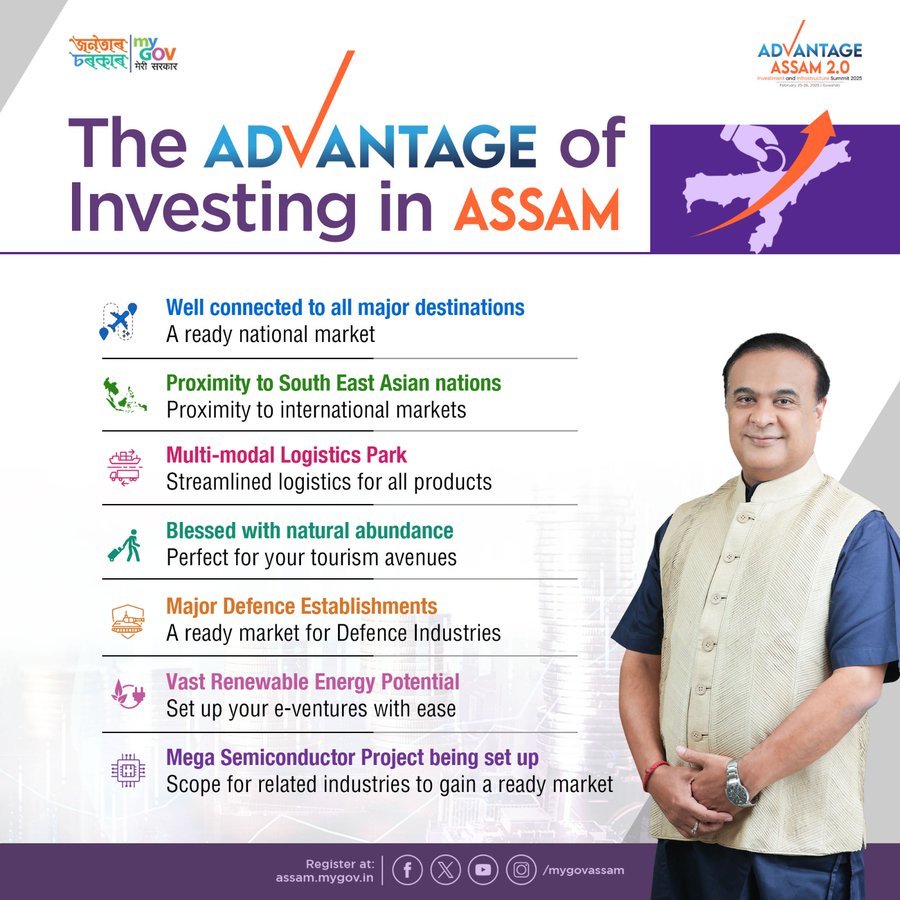
Prepared by BK Sir , Faculty & Author - ACS Dibrugarh
Advantage Assam 2.0
Overview
· Event Name: Advantage Assam 2.0 – Investment and Infrastructure Summit 2025
· Date: February 25–26, 2025
· Location: Veterinary Field, Khanapara, Guwahati, Assam, India
· Organizer: Government of Assam, led by Chief Minister Dr. Himanta Biswa Sarma
· Inauguration: By Prime Minister Narendra Modi on February 25, 2025
· Purpose: To position Assam as a prime investment destination, showcase its economic potential, and foster industrial and infrastructural growth in Northeast India.
Background
· First Edition (2018):
o Held in Guwahati, attracted ₹1 lakh crore in investment commitments via 200 Memoranda of Understanding (MoUs).
o Realization hampered by the COVID-19 pandemic and other challenges, with only partial materialization of pledges.
o Assam’s economy was valued at ₹2.75 lakh crore at the time.
· Economic Progress Since 2018:
o By 2025, Assam’s economy grew to approximately ₹6 lakh crore, doubling in six years under the BJP-led "double-engine government" (state and central synergy).
o Gross State Domestic Product (GSDP) in 2023 showed a 19.5% year-on-year increase; projected GSDP for 2024–25 is ₹6,43,089 crore (13% growth).
o Per capita income rose to ₹1,35,787 in 2023–24, a 123% increase over five years.
Objectives of Advantage Assam 2.0
1. Promote Investment Opportunities:
o Highlight Assam’s strategic location, natural resources, and investor-friendly policies to attract domestic and international investors.
2. Boost Industrial and Economic Growth:
o Diversify Assam’s economy beyond traditional sectors (tea, oil, silk) into emerging areas like semiconductors, aerospace, IT, and renewable energy.
3. Enhance Infrastructure Development:
o Focus on connectivity (road, rail, air, waterways) and industrial ecosystems to support business growth.
4. Strengthen Global and Regional Linkages:
o Position Assam as a gateway to Northeast India and Southeast Asia under India’s Act East Policy.
5. Foster Business Collaborations:
o Facilitate Business-to-Business (B2B) and Business-to-Government (B2G) partnerships for actionable outcomes.
Key Features and Highlights
· Scale and Participation:
o Largest investment promotion initiative by the Government of Assam.
o Over 20,000 attendees, including 5,000+ delegates, 400+ exhibitors, and representatives from 75 participating countries and 9 partner nations.
o Attended by Union Ministers (e.g., Piyush Goyal, Jyotiraditya Scindia, Ashwini Vaishnaw), industrialists (e.g., Gautam Adani), diplomats, and global business leaders.
· Cultural Showcase:
o Mega Jhumoir Dance on February 24, 2025, at Sarusajai Stadium, featuring over 8,600 artists from 800 tea gardens, celebrating Assam’s heritage.
· Thematic Sessions:
o 20 sessions, including 7 Union Ministerial discussions on topics like semiconductors, digital connectivity, Act East Policy, and export promotion.
o Focus areas: Healthcare, Tourism, Green Energy, Startups, Agriculture, Defence, and more.
· Exhibition:
o Over 88,000 sq ft of space with 240+ exhibitors (e.g., Tata, HUL, IOCL, ONGC).
o Assam Pavilion (10,000 sq ft) showcasing ODOP products, GI-tagged specialties, and industrial advancements.
Economic and Strategic Context
· Assam’s Unique Advantages:
o Natural Resources: Rich biodiversity, freshwater reserves, natural gas, tea, silk, and spices.
o Connectivity: 4,077 km of National Highways, 4,309 km of State Highways, 2,571 km of rail network, 11 National Waterways, 7 operational airports, and 3 Land Custom Stations.
o Strategic Location: Borders Bhutan and Bangladesh, serving as a trade hub to Southeast Asia.
· Policy Support:
o Assam Aerospace and Defence Manufacturing Policy 2025: Offers tax incentives, fiscal support, and skill development subsidies.
o Rs 25,000 crore Production Linked Incentive (PLI) corpus to accelerate industrialization.
o Single-window clearance system and streamlined regulations for ease of doing business.
· Major Investments:
o Tata Group’s ₹27,000 crore semiconductor unit in Jagiroad.
o Adani Group’s ₹50,000 crore investment across key sectors (announced post-summit).
Key Sectors in Focus
1. Traditional Strengths:
o Agriculture and Food Processing: Tea, silk, spices, and bamboo products.
o Oil and Gas: Expansion of gas-based economy and petrochemicals.
2. Emerging Sectors:
o Semiconductors and Electronics: Assam Electronics Manufacturing Cluster (EMC) with Tata’s investment.
o Aerospace and Defence: Plans for a Defence Corridor; MoUs with startups like Spacefaring Technologies (₹100 crore for Radome manufacturing).
o IT and Digital Infrastructure: IT parks and underwater communication cables in the Brahmaputra River.
o Renewable Energy: Solar, wind, and green hydrogen initiatives.
o Tourism and Hospitality: Leveraging cultural heritage and biodiversity.
3. Other Areas:
o Healthcare, pharmaceuticals, sports, and financial services.
Outcomes and Investment Commitments
· Investment Proposals:
o Secured ₹4,91,500 crore (approximately $60 billion) in investment and infrastructure proposals over two days.
o Pre-summit estimates pegged investments at ₹1 trillion (₹1 lakh crore), which increased nearly fivefold by the summit’s end.
o Post-summit updates suggest commitments rose to ₹5,18,000 crore (as per some reports).
· Job Creation:
o Projected to generate thousands of jobs, e.g., 1,300+ direct jobs from sericulture MoUs alone.
· MoUs Signed:
o Sericulture: With Rudra Enterprise (Mumbai) for geotextiles and carpets, and Windsor Fashions (Guwahati) for mosquito nets and agro-textiles.
o Defence: With startups, though major foreign players yet to commit.
· Scrutiny Measures:
o Stricter vetting rejected ₹45,000 crore in MoUs pre-summit to ensure only viable projects proceeded.
o Focus on materialization within 3–4 years.
Challenges and Critical Analysis
· Past Shortfalls:
o The 2018 summit’s ₹1 lakh crore MoUs saw limited realization due to the pandemic, bureaucratic delays, and infrastructure gaps.
o Skepticism persists about converting Advantage Assam 2.0’s ambitious pledges into tangible outcomes.
· Sectoral Gaps:
o Defence Corridor lacks firm commitments from major players; absence of the Union Defence Minister at the summit raised doubts.
o Logistics, power supply, and security for large-scale manufacturing need improvement.
· Environmental Concerns:
o Rapid industrialization risks degrading Assam’s biodiversity unless sustainable models are prioritized.
· Execution Risks:
o Success hinges on policy continuity, bureaucratic efficiency, and coordination with the central government (e.g., Ministry of Defence approvals).
Future Implications
· Economic Targets:
o Assam aims to grow its economy to $143–150 billion by 2030, leveraging Advantage Assam 2.0’s momentum.
· Regional Impact:
o Strengthens Assam’s role in India’s Act East Policy and the “Ashtalakshmi” vision for Northeast development.
· Global Positioning:
o Partnerships with countries like Singapore and Bhutan (e.g., water management talks) enhance Assam’s international outreach.
· Sustainability and Equity:
o Initiatives like the Nijut Moina Scheme (scholarships for girls) and Orunodoi Scheme (women empowerment) complement economic goals with social progress.
Conclusion
Advantage Assam 2.0 marks a pivotal moment in Assam’s transformation from a historically dependent economy to an emerging industrial hub. With unprecedented investment commitments, a focus on diverse sectors, and robust government support, the summit signals a new era of growth. However, its true success depends on overcoming past challenges, ensuring sustainable development, and translating pledges into action. If executed effectively, Assam could emerge as a powerhouse in India’s economic resurgence and a gateway to Southeast Asia.
Comments (0)
Categories
Recent posts


Q5/ Section B, APSC Mains 2024 Essay - ...
29 Jul 2024
Q8/ Section B, APSC Mains 2024 Essay- ...
29 Jul 2024
Satellite Town
21 Jul 2024



